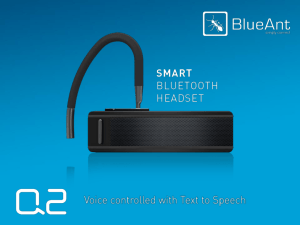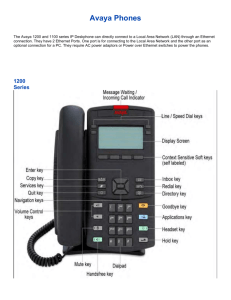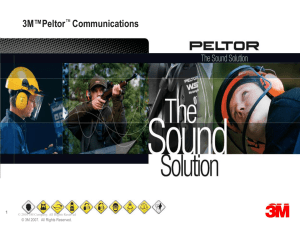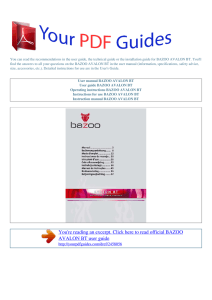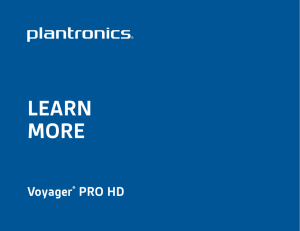Communication Headset Integrate Product Suite
advertisement
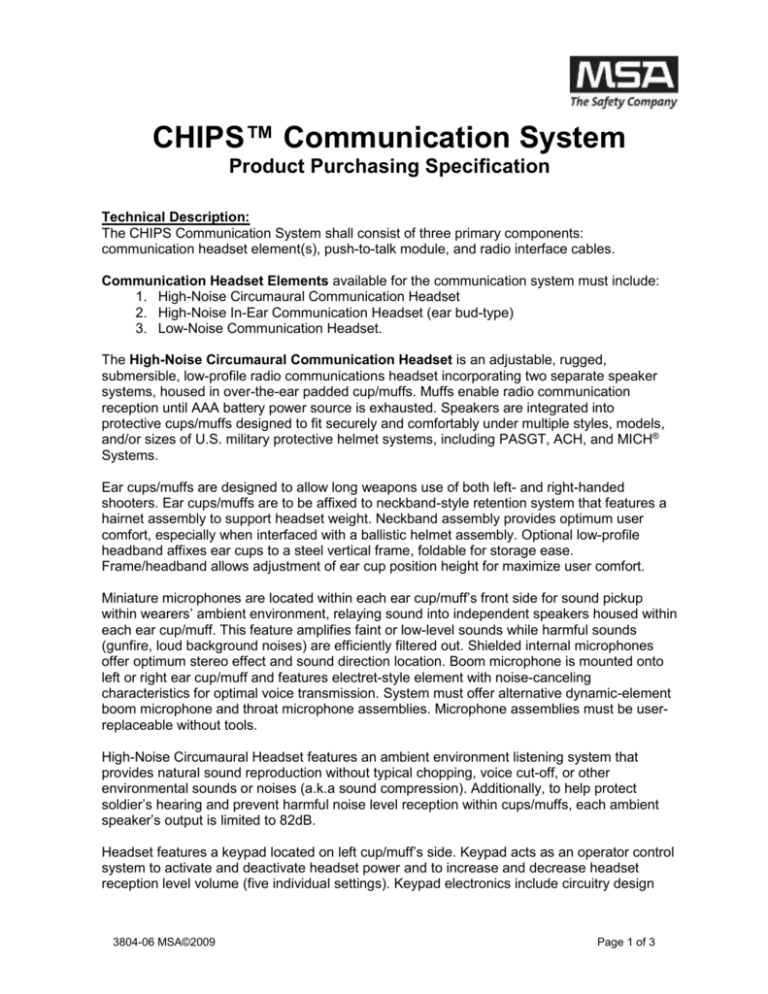
CHIPS™ Communication System Product Purchasing Specification Technical Description: The CHIPS Communication System shall consist of three primary components: communication headset element(s), push-to-talk module, and radio interface cables. Communication Headset Elements available for the communication system must include: 1. High-Noise Circumaural Communication Headset 2. High-Noise In-Ear Communication Headset (ear bud-type) 3. Low-Noise Communication Headset. The High-Noise Circumaural Communication Headset is an adjustable, rugged, submersible, low-profile radio communications headset incorporating two separate speaker systems, housed in over-the-ear padded cup/muffs. Muffs enable radio communication reception until AAA battery power source is exhausted. Speakers are integrated into protective cups/muffs designed to fit securely and comfortably under multiple styles, models, and/or sizes of U.S. military protective helmet systems, including PASGT, ACH, and MICH® Systems. Ear cups/muffs are designed to allow long weapons use of both left- and right-handed shooters. Ear cups/muffs are to be affixed to neckband-style retention system that features a hairnet assembly to support headset weight. Neckband assembly provides optimum user comfort, especially when interfaced with a ballistic helmet assembly. Optional low-profile headband affixes ear cups to a steel vertical frame, foldable for storage ease. Frame/headband allows adjustment of ear cup position height for maximize user comfort. Miniature microphones are located within each ear cup/muff’s front side for sound pickup within wearers’ ambient environment, relaying sound into independent speakers housed within each ear cup/muff. This feature amplifies faint or low-level sounds while harmful sounds (gunfire, loud background noises) are efficiently filtered out. Shielded internal microphones offer optimum stereo effect and sound direction location. Boom microphone is mounted onto left or right ear cup/muff and features electret-style element with noise-canceling characteristics for optimal voice transmission. System must offer alternative dynamic-element boom microphone and throat microphone assemblies. Microphone assemblies must be userreplaceable without tools. High-Noise Circumaural Headset features an ambient environment listening system that provides natural sound reproduction without typical chopping, voice cut-off, or other environmental sounds or noises (a.k.a sound compression). Additionally, to help protect soldier’s hearing and prevent harmful noise level reception within cups/muffs, each ambient speaker’s output is limited to 82dB. Headset features a keypad located on left cup/muff’s side. Keypad acts as an operator control system to activate and deactivate headset power and to increase and decrease headset reception level volume (five individual settings). Keypad electronics include circuitry design 3804-06 MSA©2009 Page 1 of 3 that features memory, saving wearers’ volume settings (used by previous wearer) to most recent headset power-down. Headset electronics operate via two alkaline AAA batteries. Battery life will average 600 hours of use. To help alert soldiers to impending battery demise, warning signal activates within ear cups periodically, beginning with estimated 40 hours of remaining battery life. Circumaural headset features circuit design that automatically shuts off headset following fourhour non-use period. Battery compartment is waterproof. Headset provides inbound communication monitoring capability from three simultaneous independent sources: RADIO 1 in left headset speaker, RADIO 2 in right headset speaker, and INTERCOM in both headset speakers. Headset ear cups/muffs are available in both olive drab and black. The High-Noise In-Ear Communication Headset dual-communication device offers users situational awareness via talk-through feature combined with hearing protection. In-ear system must be compatible, fitting securely and comfortably under multiple styles, models, and/or sizes of U.S. military protective helmet systems including PASGT, ACH, and MICH Systems. In-ear communication system use must not interfere with gas mask use and must be compatible with circumaural communication headsets. Miniature microphones located on each earpiece’s side pick up sounds in wearers’ ambient environment, relaying sound into independent speakers housed within each ear bud. Feature amplifies faint or low-level sounds while harmful sounds (gunfire, loud background noises) are efficiently filtered out. High-Noise In-Ear Communication Headset must be capable of supplying users with radio transmissions from three independent sources, helping to ensure that specific sources are easily distinguishable at all times. Shielded internal microphones provide optimum stereo effect and sound direction location. System uses a bone-conduction microphone to transmit outbound user communications. Headset must be capable of use in extreme situations with no common interference. In-ear system must use aural sealing foam plug that offers minimum NRR 29 rating. Aural sealing foam must be available in minimum of three sizes to help ensure proper user fit and comfort. Adjustable-length, plastic spring design improves ear bud fit and stability when worn. The Low-Noise Communication Headset dual-communication device offers users situational awareness. Earplugs may be used in required hearing protection applications. Hearing protection use must not interfere with communications through the communication system. Low-Noise Communication Headset must be compatible, fitting securely and comfortably under multiple styles, models and/or sizes of U.S. military protective helmet systems, including PASGT, ACH, and MICH Systems. Use of Low-Noise Communication System must not interfere with gas mask use and must be compatible with High-Noise In-Ear Communication Headset. Low-Noise Communication Headset must integrate bone-conductive speakers that convert incoming transmissions into vibrations transmitted through bone to users’ auditory organs. System must incorporate noise-canceling electret boom microphone assembly. Microphone positioning must be user-adjustable. Headset must be capable of receiving incoming radio 3804-06 MSA©2009 Page 2 of 3 communication from three independent sources and must maintain user’s ability to distinguish specific communication sources. Low-Noise/High-Noise Headsets are worn behind user,s heads in neckband-style configuration. Users must be able to install or remove communication devices without removing their protective ballistic helmets. The CHIPS PTT Module is the communication suite’s central product, allowing users various headset options and/ High-Noise In-Ear Communication Headset while interfacing simultaneously to one or two radios and an intercom system. CHIPS PTT Module can be operated in CHIPS PTT mode where all three communication interface ports are simultaneously fully operational. Users must have full communication capability on RADIO 1, RADIO 2, and INTERCOM simultaneously. System must offer a double-protection mode that provides users with added high-noise environment hearing protection. In this mode, users can wear High-Noise In-Ear Communication Headset and be provided with full radio/intercom communication, including the first level of hearing protection. System must allow use of High-Noise Circumaural Headset to be worn over High-Noise In-Ear Communication Headset, providing an additional level of hearing protection. To maintain user situational awareness and communication capability, external High-Noise Circumaural Headset ambient spy microphones must remain active, routing inbound sounds to users through High-Noise In-Ear Communication Headset speakers. CHIPS PTT Module must interface with three independent communication sources simultaneously: two radios and one intercom. Interfaces will include dedicated MBITR-type radio interface cable/connector and two IP68-rated quick disconnects for portable radio and intercom system. Connectors must be keyed to help ensure proper installation and are to be color-coded to ensure proper port connection. CHIPS PTT Module must be capable of identifying users’ communication source(s). When one portable radio is in use, CHIPS PTT Module routes audio signals to both headset speakers. When two portable radios are connected to CHIPS PTT Module, the unit autorecognizes dual-com mode, separating RADIO 1 and RADIO 2 audio signals into left and right ear speakers. When two portable radios and intercom system are connected to CHIPS PTT Module, radio communications will be routed to users’ left and right ears; intercom communication will be transmitted through both left and right ears. Communication routing must be done automatically, without any user interaction. CHIPS PTT Module must provide audio prompts alerting users that the module has been turned on, and which communication port, if any, is occupied. CHIPS PTT Module must meet IP68 rating without any connected headset or radio elements. CHIPS PTT Module must attach to users with a durable, rubberized, spring-loaded clip that rotates 360 degrees, allowing users to position the device’s orientation. CHIPS PTT Module must have volume up and down controls that allow users headset volume adjustment without radio volume control adjustment. CHIPS PTT Module must also feature a MODE button that allows users to turn on the module. 3804-06 MSA©2009 Page 3 of 3

